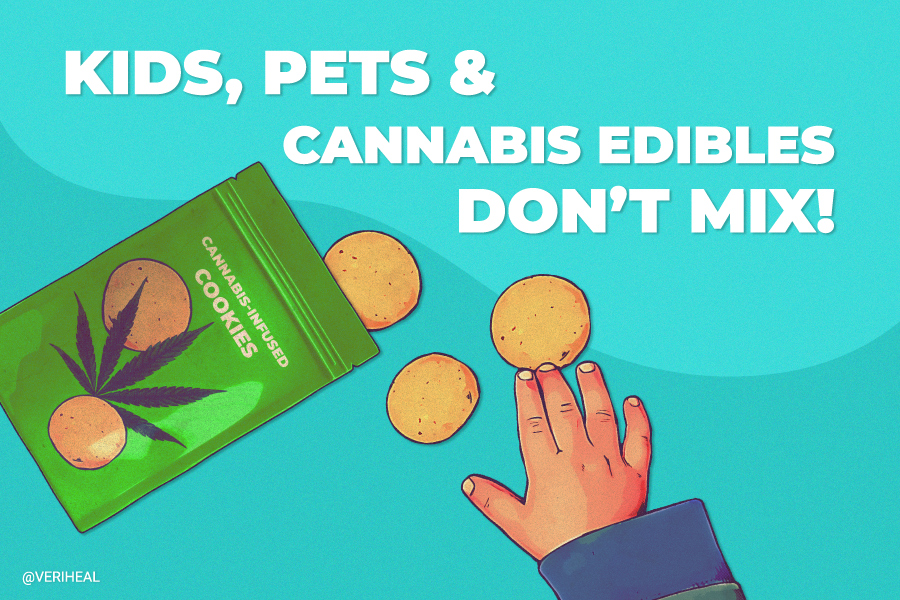There has been a recent rise in the number of children going to the emergency room due to cannabis overdose. No, these kids aren’t getting ahold of their parents’ or guardians’ cannabis and smoking it—they’re eating it in the form of cannabis-infused edibles.
Edibles can be very strong, even for adults let alone children. It is extremely important to keep edibles out of the reach of children, including the furry kids. Edibles not only look good to us, but they also look tasty and tempting to unsuspecting children and pets. Some of the most common cannabis edibles are:
- Chocolates
- Gummy candies
- Baked goods (brownies, cookies, etc.)
They also come in the form of other treats like popcorn, cheese puffs, sodas, and more. All edibles should be kept under lock and key at home if you have children or pets to help avoid accidental ingestion. What makes you feel good will have a very negative effect on a child or pet.
A child or pet can eat an edible in the blink of an eye, and then you’re both in for a bumpy ride. Luckily, cannabis won’t kill your child or pet, but it can definitely make them very sick. Depending on the dosage and age of your child or pet, you will most likely want to seek medical attention for them as soon as you realize what happened.
The strength of cannabis-infused edibles ranges from very low THC doses of around .5 to 5 milligrams all the way up to mega-doses of 4000 milligrams or more. Thankfully, with cannabis being increasingly legalized, more people are taking their kids to the hospital to seek help for accidental cannabis ingestion.
The Children’s Hospital of Colorado website says that accidental ingestion of cannabis-infused edibles is the most common form of cannabis overdoses in children today, stating:
“Marijuana ingested in this manner can have a stronger and prolonged effect, especially in children under the age of 12 years old. In these instances, kids mistake ‘edible’ marijuana [like gummy bears, brownies, lollipops, etc.] for regular food and eat it unknowingly. Small children are at higher risk based on their size and weight. Because edible products have very high amounts of marijuana, the symptoms are more severe on a small child.”
What to Expect if Your Child Eats Cannabis Edibles
If your child eats a cannabis edible, you should take them to a doctor immediately in most cases. If a small child ingests a large dose of cannabis, it could lead to breathing issues or worse. Whether or not you take them to a medical professional, you must stay awake and monitor them until their symptoms go away completely. Keep in mind that being intoxicated as a child can be very frightening.
The dosage is a big factor. If a small child eats a 10-milligram edible, they may only get a little silly and sleepy—but they could also experience nausea, vomiting, dizziness, headache, and more. If they eat 100 milligrams of THC, you can expect vomiting, diarrhea, crying, dizziness, and loss of muscle control. An experience like this is scary for everyone involved.
It’s also a good idea to keep them sitting up to avoid choking on vomit or saliva. Unfortunately, these effects will not go away in an hour or two. Depending on the age and size of the child, as well as the amount of cannabis ingested, the effects can last anywhere from four to 24 hours or more.
Don’t underestimate the seriousness of accidental ingestion of cannabis edibles by children. Pediatric ER physician Dr. Sam Wang of the Children’s Hospital of Colorado told media sources:
“The industry has evolved to have much stronger, more potent products and these edible products are no exception. Kids can get into a lot of THC in these products, and so they can have more profound symptoms, including sedation, coma. We’ve seen kids with low oxygen because their breathing is low.”
Canada waited to legalize edibles in an effort to avoid accidental overdoses. Following the country’s 2019 legalization of edibles, data shows that it’s seeing a 900% increase in the number of ER visits for cannabis overdoses in young children. According to the same data, a third of those cases involved extended hospitalization, and 4% of them ended up in ICU.
It doesn’t matter where you live—if you have edibles, consume them responsibly. Don’t leave them where children or pets can get them. Your child or pet will most likely get through the experience unharmed, but it can still be uncomfortable and scary. Cannabis is not deadly and must be consumed in impossible amounts to do harm beyond the discomforts of headache, vomiting, dizziness, loss of muscle control, diarrhea, etc.
THC can be great for adults, but not so much for children and animals. Keep your cannabis locked up at all times, and consider purchasing a lockbox just for your stash. Kids, pets, and cannabis don’t mix.
Author, Share & Comments















